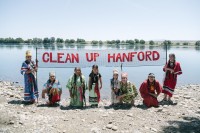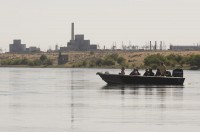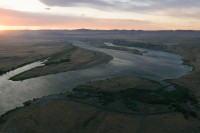Columbia River tribes offer a vision for Hanford that involves people fishing, hunting, and living along the Hanford Reach.
5 Facts about Hanford:

1.) Columbia River tribes offer a vision for Hanford that involves people fishing, hunting, and living along the Hanford Reach.
Tribes invest significant resources in advocating for Hanford cleanup. In the early 1940s, the United States removed Native Americans from Hanford
to construct top-secret nuclear reactors for the Manhattan Project. Except for this 80-year forced absence, native people have used the Hanford area since time immemorial to hunt, fish, gather food, trade, and live. This area has great traditional and religious significance to Columbia Plateau tribes and is home to multiple traditional cultural properties, traditional use areas, as well as significant ceremonial sites.

2.) Take a boat tour and view Hanford’s nuclear reactors from the water.
Take in the sweeping vistas of the Hanford Reach on a boat tour. Looming large and out of place in the beautiful shrub steppe landscape, reactors begin to appear. This portion of the Hanford Nuclear Site, the 100-Area, once contained nine plutonium production reactors, built between 1943 and 1965. Hundreds of thousands of tons of uranium fuel rods were subjected to nuclear chain reactions inside the reactors to produce tons of plutonium. During World War II and the Cold War, the United States used plutonium produced at Hanford in nuclear weapons. Years of plutonium production generated billions of gallons of liquid waste and millions of tons of solid waste and contaminated soil.

3.) The Columbia’s Hanford Reach contains important salmon spawning habitat.
The Hanford Reach is the last remaining stretch of the mainstem Columbia River where fall Chinook salmon spawn in significant numbers. The Columbia’s Hanford Reach spans 50 miles of undammed, free- flowing river and contains islands, riffles, gravel bars, oxbow ponds,
and backwater sloughs. The Reach is home to 43 species of fish, including the threatened Upper Columbia River spring-run Chinook salmon, steelhead, and bull trout. The Reach provides critical habitat
for spawning, foraging, and migration of salmon and steelhead.
4.) Toxic and radioactive pollution from the Hanford Site threatens salmon.
Toxic and radioactive groundwater plumes from Hanford threaten salmon habitat. Major contaminants present in the Hanford Reach include chromium, nitrate, tritium, strontium-90, trichloroethene, and uranium. Contaminated groundwater enters the Columbia River during the river’s low-flow periods in fall and winter. And salmon spawn in the Hanford Reach from mid-October to late-November, peaking in mid-November. Egg and fry development occurs from mid-October through May. Salmon, therefore, are most likely to come into contact with the toxic pollution during their most sensitive life stages—spawning and development. Aquatic invertebrates (insects and other animals) are also exposed to pollution in the Hanford Reach, potentially causing contamination to enter the food web. A thorough cleanup and long-term protection will ensure salmon continue to return to critical spawning grounds on the Columbia River.
5.) Gain a deeper understanding of the Hanford Reach National Monument on a hike at the scenic White Bluffs.
Across the Columbia from the Hanford Nuclear Site lies the Hanford
Reach National Monument. Designated by President Bill Clinton in 2000, the Monument covers 304 acres of varied shrub-steppe, cliff, wetland,
and river habitat. River and lake sediments left behind by the ancestral Columbia River and its tributaries formed the White Bluffs. The cliffs contain large fossil deposits, including the remains of rhinoceros, camels, and mastodons. Want to learn more about the Monument? Hike the White Bluffs or visit fws.gov/refuge/Hanford_Reach.
Critters of the Hanford Reach National Monument:
- 43 species of fish, including threatened and endangered salmon and trout;
- 42 mammal species;
- 258 bird species;
- 4 amphibian species;
- 11 reptile species; and
- Over 1,500 invertebrate species.


